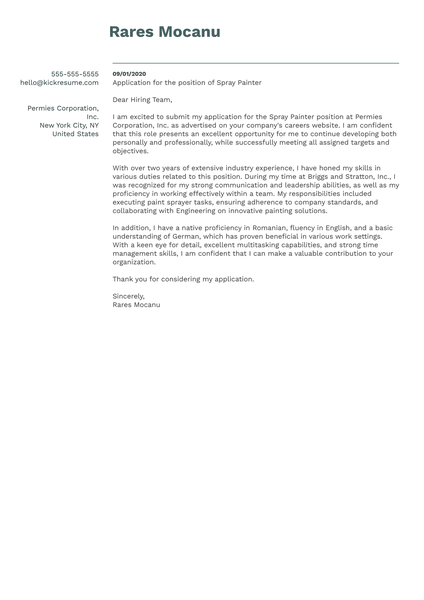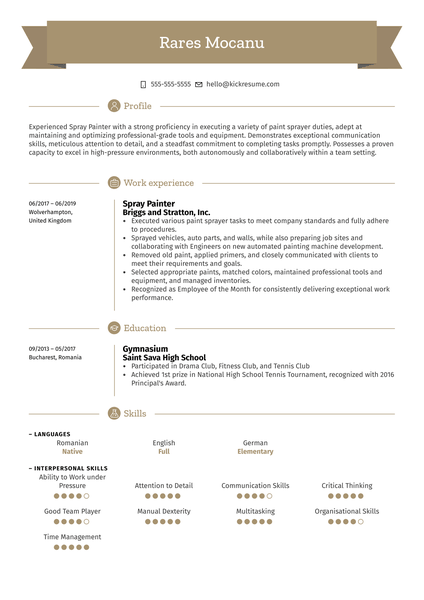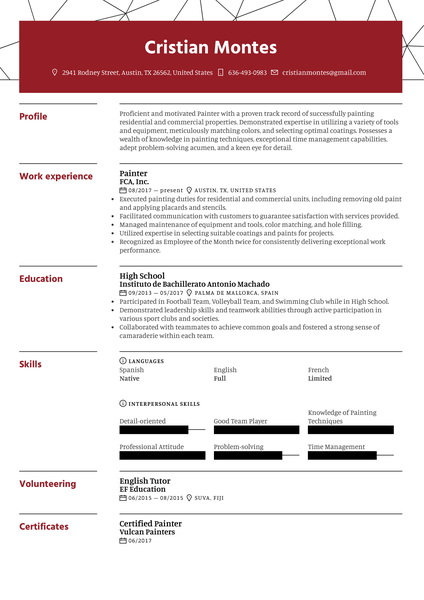If you need to brush up on your painter cover letter writing skills, you're in the right place. Do you need new sleek cover letter templates? Or, perhaps, you'd like to see some actual real-life samples? Our comprehensive guide has it all! So, dive in and discover all the best tips and detailed examples to help show the recruiters your true colours!
In this guide, we show you the key steps to writing a cover letter as a painter. Keep reading to learn all about:
- How to craft your painter cover letter header & headline
- Why your painter cover letter needs a personalized greeting
- What to include in your painter cover letter introduction
- Ways to showcase your professional value as a painter
- How to end your painter cover letter with a strong closing statement
- How to access top resources for job-seeking painters
Still looking for a job? These 100+ resources will tell you everything you need to get hired fast.
1. How to craft your painter cover letter header & headline
Like the walls and surfaces you paint, your cover letter needs a little preparation before you dive into writing the introduction and body paragraphs. As such, the first steps to writing a cover letter are to create a well-formatted header and headline.
Your cover letter header is often found in the top-left corner and includes all the identifying information about you (the applicant) and the company you are applying to. On the other hand, your cover letter headline is a brief title that helps to capture an employer’s attention and preview the information to come.
To help better illustrate how to craft each of these elements, we have provided more in-depth explanations and examples below:
Formatting the header
The header of a cover letter can vary in its formatting but should always contain between 3 to 4 lines of text that include:
- The name of the company you are applying to (& the department when applicable)
- Your name and professional title
- Your professional contact information (phone number, email address, LinkedIn, etc.)
Here is an example of a well-formatted header on a painter cover letter
To: The Home Depot, Paint Department
From: Jack Smith, Professional Painter
(123) 456-7890 | jacksmith@email.com | linkedin.com/in/jack-smith
Writing the headline
Any time you write a cover letter headline, it is crucial to always use a keyword related to the position, an eye-catching number or trigger word, a powerful adjective or verb, and a promise.
Here is an example of a well-written painter headline, followed by a breakdown of its key components
My 3 Essential Painting Skills & How I Will Apply Them at Your Company
Trigger Word/Number: 3 Skills
Keyword: Painting
Adjective/Verb: Essential, Apply
Promise: At Your Company – this serves as a promise because it indicates to the employer that you will relate your skills directly to their needs as a company.
2. How to include a personalized greeting in your painter cover letter
In general, we recommend always opting for a personalized greeting over a generalized greeting for your cover letter.
Unlike generalized greetings – such as “To Whom It May Concern” – personalized greetings address a specific person or department by name. As a result, an employer can clearly see that you have taken the time to research the company beforehand. Plus, it shows you have excellent attention to detail.
If you cannot pinpoint an exact person or department after thoroughly researching the company, you may want to try out one of these more hybrid alternatives:
To the [Company Name] Team
Or
To the [Company Name] Hiring Manager
3. How to make your painter cover letter introduction stand out
The headline and greeting of your cover letter work together to initially hook the attention of an employer. To keep them interested, your cover letter opening paragraph should include:
- A brief overview of your professional history and goals
- A statement on why you are enthusiastic about applying to this company
- A mutual acquaintance (when possible)
Here is an example to help demonstrate how to write a painter cover letter introduction
To the [Company Name] Hiring Manager,
I am a Professional Painter with 5+ years of experience painting multiple-story residential homes. My former client and your professional associate, Jane Doe, recommended I apply for this position after contracting me to re-paint her personal residence.
4. How to showcase your professional value as a painter
Following your introduction are the body paragraphs of your cover letter. These paragraphs are where you will offer more insight into your professional background and what qualifies you for the position you are applying for.
A strong cover letter will include between 2 to 4 body paragraphs that offer in-depth answers to these key questions:
- What excites you about working at this company?
- What do you hope to learn from working at this company?
- What accomplishments or qualifications make you stand out as an applicant?
- What key skills do you possess that are relevant to the position?
Focusing on describing your relevant accomplishments is essential. In doing so, you will show employers the real-life value you are capable of bringing to their company.
Here is an example of how to describe an accomplishment in a painter cover letter
As a Commercial Painter for [Former Employer], I sourced an affordable supplier for new spraying equipment, increasing the efficiency of standard exterior painting projects by 45%. Additionally, I worked directly with clients and provided an excellent customer experience, resulting in a 4.8-star rating on Home Advisor.
5. How to end your painter cover letter with a strong closing statement
To finish off your cover letter strong, you need a thoughtful closing statement that includes:
- An enthusiastic sentence saying you are looking forward to hearing from them
- An additional sentence stating you will follow up, including how you will contact them or how they can contact you
- A formal sign-off
Here is an example of an effective closing statement from a painter’s cover letter
As an addition to your Professional Painting team, I will bring a high level of both quality and professionalism to my work. I am eager to speak with you directly about this position and would like to set up a meeting time within the next week. The best time to reach me is any day of the week between 10 a.m. to 4 p.m. at (123) 456-7890.
With Appreciation,
[Applicant Name]
Follow this cover letter outline for maximum success.
6. Top resources for job-seeking painters
Now you're more than well-equipped to make your cover letter shine. But before you put the pen to paper, you need to find a job posting to apply for. The process of job hunting can be an arduous one. So, to make things a bit easier for you, we've prepared a list of resources that might led to to your dream job:
- Industry-specific job boards: You can start by visiting websites that cater to professional painters exclusively. For example, take a look at ConstructionJobs, or TradeSource.
- General job boards: Although websites like Indeed, Glassdoor, or SimplyHired have broad focus, by using specific keywords like "professional painter," "residential painter," or "commercial painting," you can find a wide range of painting jobs across different regions.
- LinkedIn: It's not just a great platform for networking, but also for job searching. Use the job search feature to find painting positions and connect with potential employers in the painting industry.
- Professional associations: Besides job listings, associations like the Painting Contractors Association (PCA), the Painting and Decorating Association (PDA), or the International Union of Painters and Allied Trades (IUPAT) can give you access to networking events, further training, and latest industry news.
- Continuous learning: To stay on top of the competition, you need to keep learning and upskilling. Consider taking on courses and certifications offered by, for example, Painters USA, Painters Institute, Coursera, edX, or LinkedIn Learning.
- Specialized publications: Another way to keep up with the latest industry innovations, technologies, and regulations, is to regularly check media such as: “Paint Square,” “Professional Painter Magazine,” or “Paint & Coatings Industry (PCI) Magazine.”
Remember that your success rate of converting job postings into job offers leans heavily on first impressions. And what better way to kickstart your job search than by having a persuasive and well-crafted cover letter?
Painter Cover Letter FAQ
Is it necessary to mention my soft skills in a professional painter cover letter?
Yes! Soft skills like communication, time management, and problem-solving all play a vital role in virtually every job. And while the core of your job revolves around painting, you'll have to deal with customers and clients on a daily basis. So, you want to highlight any soft skills you have that would be beneficial in a painting role.
How long should my cover letter be?
Always aim to keep your cover letter under one page. It's meant to introduce you and your resume, not to provide the whole story. Concentrate on the most relevant aspects of your experience, skills, and education for the role. But, be careful not to just repeat the information on your resume. A cover letter should complement it and put it into context.
Can I include a testimonial or recommendation in my painter cover letter?
Yes, if you have a relevant, powerful testimonial from a client or employer, feel free to include an excerpt in your cover letter. After all, authentic and positive feedback can give an impactful boost to your application, as well as make you stand out from the competition.
What's the most effective way to showcase my skills in a professional painter cover letter?
To highlight your skills, concentrate on the key competencies requested in the job description. Also, be specific and provide examples of your painting experience. You can do so by outlining a particular problem you've encountered and what you did to successfully solve it. Remember, it's not just about stating you have the skills, it's showing how you've utilized them effectively.
What are common mistakes to avoid in a professional painter cover letter?
Avoid using a generic, one-size-fits-all cover letter. Each letter should be tailor-made for the specific role you're applying for. Grammar and spelling mistakes are another major faux-pas. Always proofread your letter several times or, even better, ask someone else to check it too.










